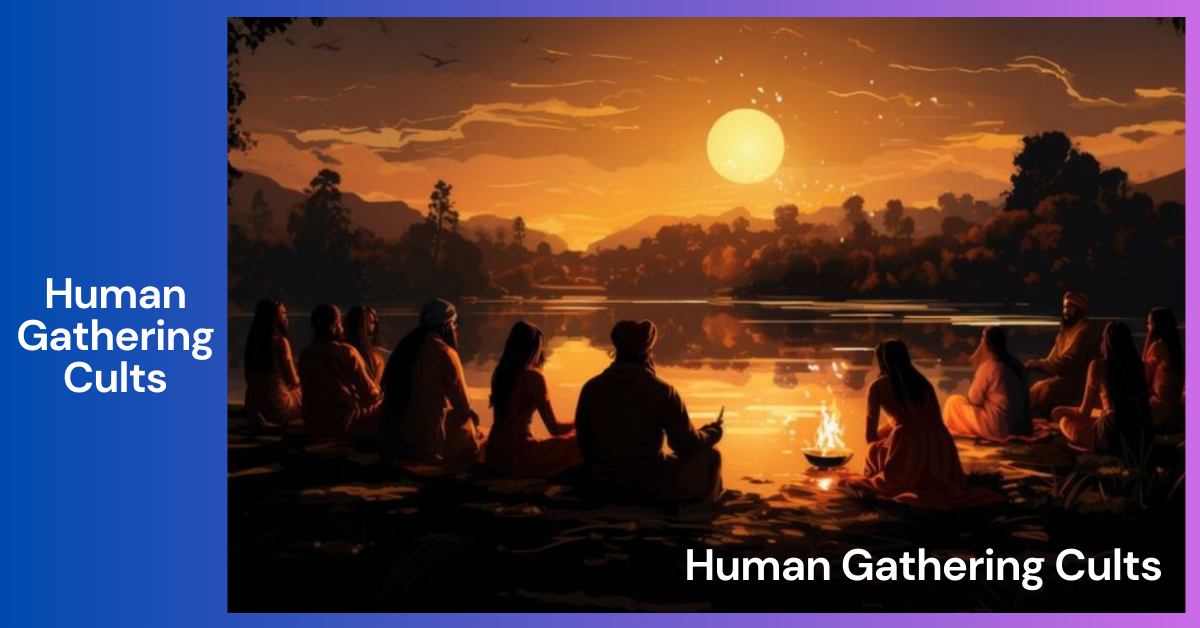
Human gathering cults have emerged as a fascinating and multifaceted concept in contemporary society.
A “human gathering cult” focuses on large-scale collective events, emphasizing shared experiences and community. Unlike traditional cults with specific beliefs or leaders, it highlights the social and emotional impact of mass gatherings.
Unlike traditional cults that are often tied to specific ideologies or charismatic leaders, human gathering cults center around the collective experience of large groups of people coming together.
This article explores what defines a human gathering cult, its characteristics, historical context, psychological impact, and notable examples.
Defining Human Gathering Cults
What is a Human Gathering Cult?
The term “human gathering cult” refers to groups or movements that prioritize large-scale gatherings and the collective experiences derived from them.
These gatherings can vary in purpose, from spiritual and artistic to political and social, but they all share a common focus on bringing people together in significant numbers.
Unlike traditional cults that often revolve around a specific doctrine or charismatic figure, human gathering cults emphasize the social and emotional impact of collective experiences.
Key Characteristics
- Large-Scale Gatherings: The hallmark of human gathering cults is their emphasis on organizing large events or meetings. These can range from local community events to massive international festivals.
- Collective Experience: Participants are drawn to the shared experiences that come from being part of a large group. These experiences often foster a sense of unity and belonging.
- Rituals and Traditions: Many human gathering cults develop their own unique rituals or traditions to enhance the collective experience. These can include specific ceremonies, activities, or practices that are central to their gatherings.
- Community Building: Central to these groups is the creation of a close-knit community. Members often find a strong sense of identity and connection within the group.
- Role of Technology: Modern human gathering cults frequently utilize technology to organize and expand their reach. Social media, online platforms, and other digital tools play a crucial role in facilitating these gatherings.
Historical Context and Evolution
Origins of Human Gathering Cults
The concept of gathering people together is not a new phenomenon.
Throughout history, societies have organized large-scale gatherings for various purposes—religious ceremonies, political rallies, social events, and more.
However, the modern notion of human gathering cults emphasizes the social and emotional dynamics of these large gatherings, reflecting contemporary shifts in how people connect and form communities.
Evolution Over Time
With the rise of digital technology, human gathering cults have evolved significantly. Traditional in-person gatherings have expanded into virtual spaces, allowing people from different locations to join in.
This evolution reflects broader societal changes in communication and community-building.
For example, the rise of social media has enabled these groups to coordinate events more efficiently and reach a global audience.
Virtual events and online communities have become integral to the modern human gathering cult, showcasing how technology shapes collective experiences.
Reasons People Join Human Gathering Cults
Seeking Connection and Belonging
One of the primary reasons individuals are drawn to human gathering cults is the search for connection and belonging.
In an increasingly fragmented society, these groups offer a sense of community and inclusion that many find appealing.
The shared experiences and collective emotions can create a powerful sense of unity among members.
Experiencing Collective Emotions
Human gathering cults often provide opportunities for participants to experience collective emotions and shared moments.
These experiences can be deeply impactful, offering a sense of purpose and emotional resonance that individuals may not find in their everyday lives.
Escaping Everyday Life
For some, the immersive nature of human gathering cults offers a temporary escape from the challenges and monotony of daily life.
The intense experiences and communal activities can provide a refreshing break from routine and a chance to engage in a different social reality.
Notable Examples of Human Gathering Cults
The Burning Man Festival
Burning Man is one of the most well-known examples of a human gathering cult.
Held annually in the Nevada desert, the festival attracts tens of thousands of participants who come together to create a temporary city dedicated to art, self-expression, and community.
The event is characterized by its large-scale gatherings, unique rituals, and emphasis on communal living.
Participants in Burning Man engage in various activities, from building elaborate art installations to participating in themed camps and performances.
The festival’s focus on creativity, self-expression, and community-building aligns with the core characteristics of a human gathering cult.
Mega-Church Gatherings
Mega-churches are another example of human gathering cults. These churches host large worship services and community events, often attracting thousands of attendees.
Mega-church gatherings typically include elaborate productions, music, and communal activities designed to foster a strong sense of community among participants.
The emphasis on large-scale gatherings and collective worship experiences makes mega-churches a prime example of human gathering cults in a religious context.
Large-Scale Political and Social Movements
Large-scale political rallies and social movements can also be considered human gathering cults. These events often bring together large numbers of people united around common causes or goals.
The collective action and sense of solidarity experienced at these gatherings can be similar to those found in other human gathering cults.
For example, political protests or social justice marches can create a strong sense of community and shared purpose among participants, reflecting the core elements of human gathering cults.
The Psychological Impact of Human Gathering Cults
Emotional and Psychological Benefits
Participating in human gathering cults can offer significant emotional and psychological benefits.
The sense of belonging and shared purpose experienced in these groups can lead to increased happiness, reduced feelings of loneliness, and improved mental well-being.
The collective experiences and connections made during these gatherings can create lasting positive impacts on individuals.
Potential Risks and Drawbacks
However, there are potential risks associated with human gathering cults. The intense focus on collective experiences can sometimes lead to a loss of individual identity or pressure to conform.
Additionally, the emotional highs associated with these gatherings may be followed by periods of emotional low, leading to a sense of emptiness or dissatisfaction once the event is over.
It’s important for participants to be aware of these risks and to seek a balanced approach to involvement in human gathering cults.
Ensuring that personal boundaries are maintained and that participation is driven by genuine interest rather than pressure can help mitigate potential negative effects.
The Role of Technology in Human Gathering Cults
Facilitating Connections
Technology plays a crucial role in modern human gathering cults.
Social media platforms, event management tools, and communication apps help organize and coordinate gatherings, making it easier for people to connect and participate.
Online platforms enable individuals to engage with communities and events from different locations, broadening the reach and impact of these gatherings.
Expanding Reach
The use of technology also allows human gathering cults to reach a global audience.
Virtual gatherings and online communities enable people from various geographical locations to join in and share experiences, expanding the scope of these gatherings.
This global reach enhances the sense of connection and solidarity among participants, regardless of their physical location.
Challenges and Considerations
While technology offers many benefits, it also presents challenges.
Issues related to privacy, digital burnout, and misinformation can impact the effectiveness and integrity of human gathering cults.
It’s important for organizers and participants to be mindful of these challenges and to strive for transparency and inclusivity in their use of technology.
Human Gathering Cults vs. Traditional Cults
Differences in Focus and Practice
Human gathering cults differ from traditional cults in several key ways. Traditional cults often revolve around specific ideologies, religious beliefs, or charismatic leaders.
In contrast, human gathering cults focus on the collective experience and social dynamics of large groups. The emphasis is on the communal aspects of gatherings rather than specific doctrines or leaders.
Similarities and Overlaps
Despite these differences, there are similarities between human gathering cults and traditional cults.
Both types of groups can create strong bonds among members and foster a sense of belonging and community. Additionally, both can involve rituals or practices that enhance the collective experience.
Ethical Considerations and Criticisms
Ethical Implications
The concept of human gathering cults raises several ethical considerations. The manipulation of collective emotions and the potential for exploitation of individuals seeking connection can be problematic.
It is important for organizers and participants to be aware of these issues and to create environments that prioritize the well-being and autonomy of all members.
Criticisms and Concerns
Critics of human gathering cults may argue that these groups can lead to unhealthy dependencies or social pressures.
Concerns about the commercialization of gatherings and the impact on individual well-being are also common criticisms.
Addressing these concerns involves ensuring that participation is voluntary, respectful, and centered on positive, supportive interactions.
Conclusion
Human gathering cults represent a unique and evolving aspect of modern social dynamics.
By focusing on the collective experiences and emotional impact of large-scale gatherings, these groups offer valuable insights into the power of community and the search for connection.
As technology continues to shape how we interact, the phenomenon of human gathering cults will likely continue to evolve, presenting both opportunities and challenges for individuals and communities.
Understanding human gathering cults helps us appreciate the ways in which collective experiences influence our lives and shape our social landscapes.
By acknowledging both the benefits and potential risks, we can navigate these groups with a balanced perspective, ensuring that participation remains a positive and enriching experience.
FAQs about Human Gathering Cults
What distinguishes a human gathering cult from traditional cults?
Human gathering cults focus on large-scale collective experiences rather than specific beliefs or leaders. They emphasize the emotional and social impact of bringing people together.
How do human gathering cults use technology?
These groups leverage technology to organize and expand their gatherings, utilizing social media and online platforms to connect with a global audience and facilitate virtual events.
What are some common examples of human gathering cults?
Examples include the Burning Man Festival and mega-church gatherings, which center around large, communal events and shared experiences rather than specific doctrines.
Can participating in human gathering cults be harmful?
While these gatherings offer community and connection, potential risks include loss of individual identity and emotional highs followed by lows. It’s important to maintain personal boundaries and awareness.
Why do people feel drawn to human gathering cults?
People are often attracted to these groups for a sense of belonging, shared purpose, and the opportunity to experience collective emotions and escape everyday life pressures.
How do human gathering cults impact mental health?
Participating can improve well-being by fostering a sense of community and reducing loneliness, but it may also lead to emotional dependency or dissatisfaction after the event.
What role do rituals play in human gathering cults?
Rituals and traditions in these groups enhance the collective experience and foster a sense of unity among participants. They are integral to creating memorable and impactful communal events.





